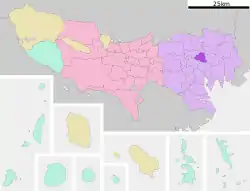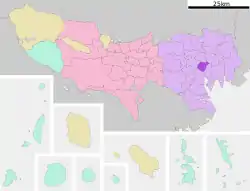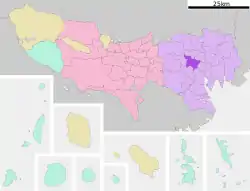Iidabashi Station
Iidabashi Station (飯田橋駅, Iidabashi-eki) is a major interchange railway station which straddles Tokyo's Chiyoda, Shinjuku and Bunkyō wards. It was originally built as Iidamachi Station (albeit in a slightly different location), terminus of the then Kōbu Railway, precursor to today's Chūō Line. The Ōedo Line addition to the station in 2000 was designed by architect Makoto Sei Watanabe.[1]
JB16 T06 Y13 N10 E06 Iidabashi Station 飯田橋駅 | ||||||||||||||||||||||||||||||||||||||||||||||
|---|---|---|---|---|---|---|---|---|---|---|---|---|---|---|---|---|---|---|---|---|---|---|---|---|---|---|---|---|---|---|---|---|---|---|---|---|---|---|---|---|---|---|---|---|---|---|
 JR East west entrance, July 2020 | ||||||||||||||||||||||||||||||||||||||||||||||
| Location | Chiyoda, Tokyo Japan | |||||||||||||||||||||||||||||||||||||||||||||
| Operated by | ||||||||||||||||||||||||||||||||||||||||||||||
| Line(s) |
| |||||||||||||||||||||||||||||||||||||||||||||
| Other information | ||||||||||||||||||||||||||||||||||||||||||||||
| Station code |
| |||||||||||||||||||||||||||||||||||||||||||||
| History | ||||||||||||||||||||||||||||||||||||||||||||||
| Opened | 1928 | |||||||||||||||||||||||||||||||||||||||||||||
| Services | ||||||||||||||||||||||||||||||||||||||||||||||
| ||||||||||||||||||||||||||||||||||||||||||||||
Lines
Iidabashi Station is served by the following above-ground and subway lines.
Above ground
- Chūō-Sōbu Line (JB16)
Subway lines
- Tokyo Metro Tōzai Line (T-06)
- Tokyo Metro Yūrakuchō Line (Y-13)
- Tokyo Metro Namboku Line (N-10)
- Toei Ōedo Line (E-06)
Station layout
The JR East station has one island platform, serving the up and down local lines; there is no platform for the parallel rapid double track (for longer-distance commuter and express Chūō Line trains). The station is located on the inside of the Outer Moat. It is elevated over Mejiro-dori, a major thoroughfare from the Imperial Palace towards Ikebukuro.
JR East
| 1 | JB Chūō-Sōbu Line | for Ochanomizu, Akihabara, and Chiba |
| 2 | JB Chūō-Sōbu Line | for Yotsuya, Shinjuku, Nakano, and Mitaka |
 Chuo-Sobu Line platforms, 2020. The bypass tracks on the right are for rapid trains.
Chuo-Sobu Line platforms, 2020. The bypass tracks on the right are for rapid trains.
Tokyo Metro
| 1 | T Tokyo Metro Tozai Line | for Ōtemachi, Nishi-Funabashi TR Toyo Rapid Railway Line for Tōyō-Katsutadai JB Chuo-Sobu Line for Tsudanuma |
| 2 | T Tokyo Metro Tozai Line | for Takadanobaba, Nakano JB Chuo-Sobu Line for Mitaka |
| 3 | Y Tokyo Metro Yurakucho Line | for Nagatachō, Yūrakuchō, Toyosu, and Shin-Kiba |
| 4 | Y Tokyo Metro Yurakucho Line | for Ikebukuro TJ Tobu Tojo Line for Shinrinkoen |
| 5 | N Tokyo Metro Namboku Line | for Komagome, Akabane-Iwabuchi SR Saitama Rapid Railway Line to Urawa-Misono |
| 6 | N Tokyo Metro Namboku Line | for Nagatachō, Shirokane-Takanawa, Meguro MG Tōkyū Meguro Line to Hiyoshi |
 Tozai Line platforms, February 2020
Tozai Line platforms, February 2020 Yurakucho Line platforms, 2016
Yurakucho Line platforms, 2016
History
The present-day JR East station opened on 15 November 1928.[2]
In 2014, it was announced that the JR East platforms were to be moved and rebuilt approximately 200 m southwest to reduce platform gaps on a sharply curved section of the platform.[3][4] The new platforms, along with a new west station building, opened on July 12, 2020.[5]
Passenger statistics
In fiscal 2013, the JR East station was used by an average of 91,196 passengers daily (boarding passengers only), making it the 46th-busiest JR East station.[6] Over the same fiscal year, the Tokyo Metro station was used by an average of 173,224 passengers daily (exiting and entering passengers), making it the twelfth-busiest station operated by Tokyo Metro.[7] In fiscal 2013, the Toei station was used by an average of 14,577 passengers daily (boarding passengers only).[8] The average daily passenger figures for JR East and Tokyo Metro in previous years are as shown below.
| Fiscal year | JR East | Tokyo Metro |
|---|---|---|
| 2000 | 91,145[9] | |
| 2005 | 88,647[10] | |
| 2010 | 90,363[11] | |
| 2011 | 90,763[12] | 166,452[13] |
| 2012 | 91,359[14] | 169,830[15] |
| 2013 | 91,196[6] | 173,224[7] |
- Note that JR East figures are for boarding passengers only.
Surrounding area
Koishikawa Kōrakuen Garden can be reached by walking from this station. The Iidabashi district extends south and west of the station, and the Kagurazaka extends north and east. The station spans the Kanda River, which separates these two neighborhoods and at this point runs from the southwest towards the northeast.
See also
References
- Capanna, Allesandra (2015). "BiOrganic Design: A New Method for Architecture and the City". In Williams, Kim; Ostwald, Michael J. (eds.). Architecture and Mathematics from Antiquity to the Future: Volume II: The 1500s to the Future. Birkhäuser. pp. 586–592. ISBN 978-3-319-00143-2.
- 各駅情報(飯田橋駅) [Station Information (Iidabashi Station)] (in Japanese). Japan: East Japan Railway Company. Retrieved 27 June 2012.
- "JR East to move Iidabashi Station by 200 meters to reduce safety risks". Japan Times. Japan: The Japan Times Ltd. 3 July 2014. Retrieved 3 July 2014.
- JR中央線飯田橋駅ホームにおける抜本的な安全対策の着手について [Start on major safety improvements on JR Chuo Line Iidabashi Station platforms] (PDF). News release (in Japanese). Japan: East Japan Railway Company. 2 July 2014. Retrieved 3 July 2014.
- "隙間33センチ、転落相次ぐ「都内で最も危険なホーム」解消へ JR飯田橋駅". Mainichi Daily News (in Japanese). 9 July 2020. Retrieved 4 October 2020.
- 各駅の乗車人員 (2013年度) [Station passenger figures (Fiscal 2013)] (in Japanese). Japan: East Japan Railway Company. Archived from the original on 6 May 2001. Retrieved 18 September 2014.
- 各駅の乗降人員ランキング [Station usage ranking] (in Japanese). Tokyo Metro. Retrieved 18 September 2014.
- 各駅乗降人員一覧 [Station usage figures] (in Japanese). Tokyo Metropolitan Bureau of Transportation. Retrieved 18 September 2014.
- 各駅の乗車人員 (2000年度) [Station passenger figures (Fiscal 2000)] (in Japanese). Japan: East Japan Railway Company. Archived from the original on 9 October 2014. Retrieved 18 September 2014.
- 各駅の乗車人員 (2005年度) [Station passenger figures (Fiscal 2005)] (in Japanese). Japan: East Japan Railway Company. Archived from the original on 9 October 2014. Retrieved 18 September 2014.
- 各駅の乗車人員 (2010年度) [Station passenger figures (Fiscal 2010)] (in Japanese). Japan: East Japan Railway Company. Archived from the original on 6 October 2014. Retrieved 18 September 2014.
- 各駅の乗車人員 (2011年度) [Station passenger figures (Fiscal 2011)] (in Japanese). Japan: East Japan Railway Company. Archived from the original on 8 October 2014. Retrieved 18 September 2014.
- 駅別乗降人員順位表(2011年度1日平均) [Station passenger figures (Fiscal 2011)] (in Japanese). Japan: Tokyo Metro. Retrieved 18 September 2014.
- 各駅の乗車人員 (2012年度) [Station passenger figures (Fiscal 2012)] (in Japanese). Japan: East Japan Railway Company. Archived from the original on 7 October 2014. Retrieved 18 September 2014.
- 各駅の乗降人員ランキング (2012年) [Station usage ranking (2012)] (in Japanese). Tokyo Metro. Retrieved 18 September 2014.
External links
| Wikimedia Commons has media related to Iidabashi Station. |
- Iidabashi Station information (JR East) (in English)
- Iidabashi Station information (Tokyo Metro) (in English)
- Iidabashi Station information (Toei) (in English)
- Refurbishment Design concept




